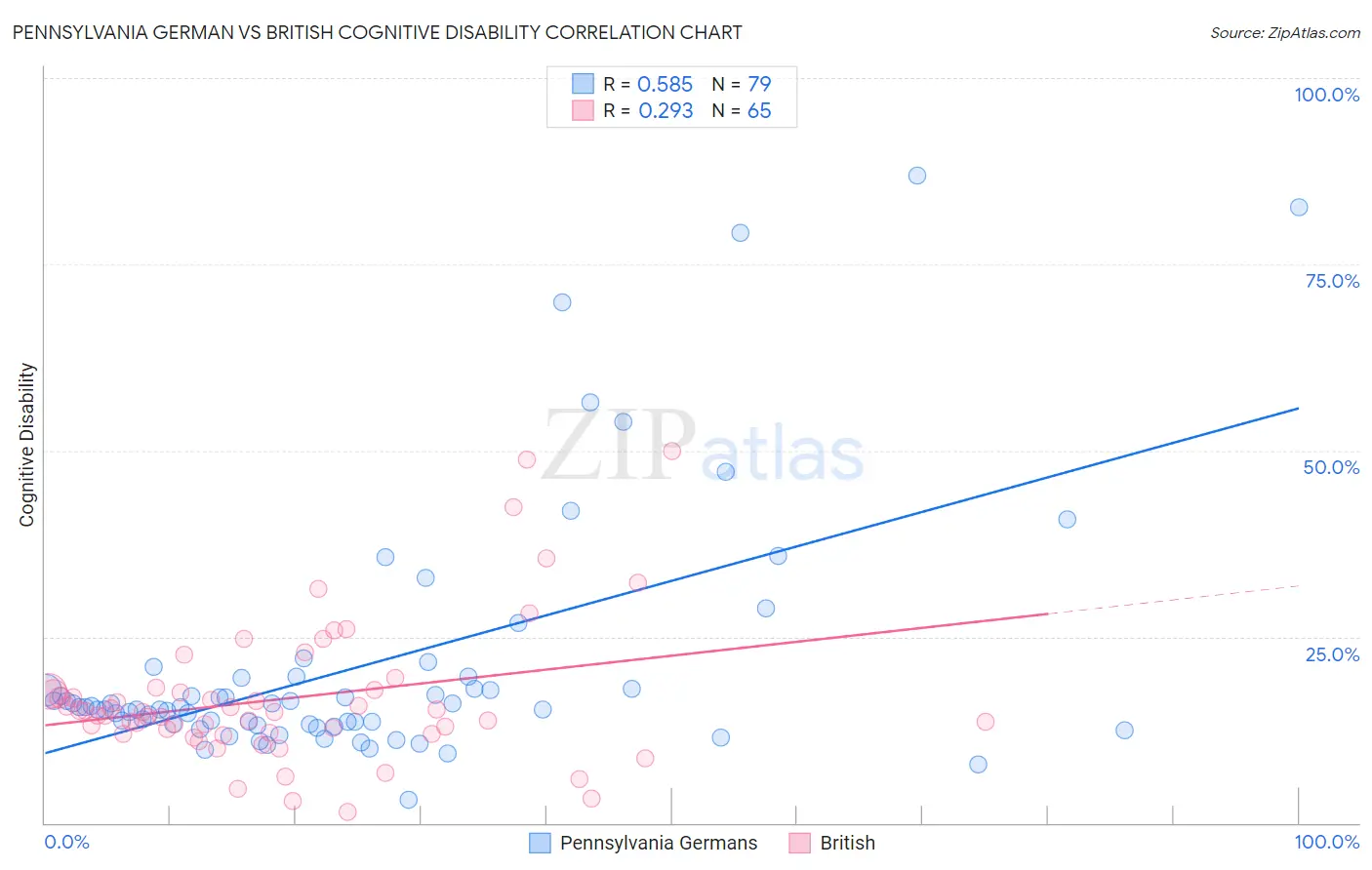Pennsylvania German vs British Cognitive Disability
COMPARE
Pennsylvania German
British
Cognitive Disability
Cognitive Disability Comparison
Pennsylvania Germans
British
16.6%
COGNITIVE DISABILITY
99.7/ 100
METRIC RATING
58th/ 347
METRIC RANK
17.0%
COGNITIVE DISABILITY
89.3/ 100
METRIC RATING
143rd/ 347
METRIC RANK
Pennsylvania German vs British Cognitive Disability Correlation Chart
The statistical analysis conducted on geographies consisting of 234,106,123 people shows a substantial positive correlation between the proportion of Pennsylvania Germans and percentage of population with cognitive disability in the United States with a correlation coefficient (R) of 0.585 and weighted average of 16.6%. Similarly, the statistical analysis conducted on geographies consisting of 531,402,976 people shows a weak positive correlation between the proportion of British and percentage of population with cognitive disability in the United States with a correlation coefficient (R) of 0.293 and weighted average of 17.0%, a difference of 2.6%.

Cognitive Disability Correlation Summary
| Measurement | Pennsylvania German | British |
| Minimum | 3.1% | 1.5% |
| Maximum | 87.0% | 50.0% |
| Range | 83.8% | 48.5% |
| Mean | 21.1% | 16.7% |
| Median | 15.5% | 14.9% |
| Interquartile 25% (IQ1) | 13.2% | 12.0% |
| Interquartile 75% (IQ3) | 19.5% | 17.7% |
| Interquartile Range (IQR) | 6.3% | 5.7% |
| Standard Deviation (Sample) | 16.7% | 9.5% |
| Standard Deviation (Population) | 16.6% | 9.4% |
Similar Demographics by Cognitive Disability
Demographics Similar to Pennsylvania Germans by Cognitive Disability
In terms of cognitive disability, the demographic groups most similar to Pennsylvania Germans are Immigrants from Peru (16.6%, a difference of 0.0%), Romanian (16.6%, a difference of 0.010%), Immigrants from England (16.6%, a difference of 0.070%), Austrian (16.6%, a difference of 0.080%), and Bhutanese (16.6%, a difference of 0.080%).
| Demographics | Rating | Rank | Cognitive Disability |
| Immigrants | Korea | 99.8 /100 | #51 | Exceptional 16.5% |
| Soviet Union | 99.8 /100 | #52 | Exceptional 16.5% |
| Swedes | 99.8 /100 | #53 | Exceptional 16.5% |
| Immigrants | Iran | 99.8 /100 | #54 | Exceptional 16.5% |
| Immigrants | Venezuela | 99.7 /100 | #55 | Exceptional 16.5% |
| Austrians | 99.7 /100 | #56 | Exceptional 16.6% |
| Bhutanese | 99.7 /100 | #57 | Exceptional 16.6% |
| Pennsylvania Germans | 99.7 /100 | #58 | Exceptional 16.6% |
| Immigrants | Peru | 99.7 /100 | #59 | Exceptional 16.6% |
| Romanians | 99.7 /100 | #60 | Exceptional 16.6% |
| Immigrants | England | 99.6 /100 | #61 | Exceptional 16.6% |
| Czechoslovakians | 99.6 /100 | #62 | Exceptional 16.6% |
| Argentineans | 99.6 /100 | #63 | Exceptional 16.6% |
| Venezuelans | 99.6 /100 | #64 | Exceptional 16.6% |
| Colombians | 99.6 /100 | #65 | Exceptional 16.6% |
Demographics Similar to British by Cognitive Disability
In terms of cognitive disability, the demographic groups most similar to British are Immigrants from Brazil (17.0%, a difference of 0.0%), Carpatho Rusyn (17.0%, a difference of 0.020%), French (17.0%, a difference of 0.050%), Chilean (17.0%, a difference of 0.050%), and Aleut (17.0%, a difference of 0.050%).
| Demographics | Rating | Rank | Cognitive Disability |
| Israelis | 91.0 /100 | #136 | Exceptional 17.0% |
| Immigrants | Norway | 90.9 /100 | #137 | Exceptional 17.0% |
| Welsh | 90.8 /100 | #138 | Exceptional 17.0% |
| French | 90.0 /100 | #139 | Excellent 17.0% |
| Chileans | 89.9 /100 | #140 | Excellent 17.0% |
| Aleuts | 89.9 /100 | #141 | Excellent 17.0% |
| Carpatho Rusyns | 89.6 /100 | #142 | Excellent 17.0% |
| British | 89.3 /100 | #143 | Excellent 17.0% |
| Immigrants | Brazil | 89.3 /100 | #144 | Excellent 17.0% |
| Immigrants | South Eastern Asia | 88.7 /100 | #145 | Excellent 17.0% |
| Costa Ricans | 88.0 /100 | #146 | Excellent 17.0% |
| Scotch-Irish | 85.9 /100 | #147 | Excellent 17.1% |
| French Canadians | 85.7 /100 | #148 | Excellent 17.1% |
| Cypriots | 85.7 /100 | #149 | Excellent 17.1% |
| Basques | 85.5 /100 | #150 | Excellent 17.1% |